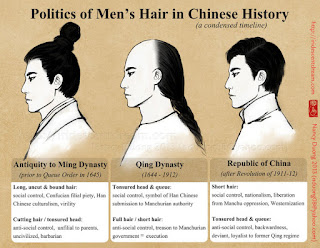In an exquisitely American moment, your Katonomist was
sipping an ice-cold
Diet Root Beer (collective wincing by non-American readers)
when a thoroughly American movement caught her eye: the now delayed
US government’s moves
to use trademark law to control American biker gangs.
Previously reported by the
IPKat in 2008, the government has been trying to control the use of the Mongols Motorcycle
Club’s
trademark to curb the club’s activities by limiting the wearing of the club’s
colours and symbols.
According to the club’s
website, the Mongols are, “The baddest 1%er Motorcycle Club known worldwide.”
I’m assuming that the 1%er does not refer to their position in the income distribution curve but the concept that the members are not part of the law-abiding
99% of motorcyclists.
 |
| Statement hair |
The current trademark, which presumably replaces a
registration abandoned in 2014, includes the description code, “an image of a man with sunglasses,
mustache, and queue.”
(No, not the
British hobby, but the
Manchu hairstyle.)
You may be wondering where the economics bit is going to
kick in.
Here it is – the US
government is seeking the limit the use of marks commonly used by members
to signal membership.
Trademarks play a key role in signalling information.
Their colours, symbols and dress can easily identify members
of the club.
The Mongols have a
well-developed brand that relies heavily on this trademark and the signalling function it provides.
By limiting the trademark and the brand, the US
government hopes to curb the club’s activities.
 |
| Modern queue and bike |
Signalling, and in this case, status signalling, is a useful
economic function which reduces
information asymmetry.
Information asymmetry, in which parties
engaging in transactions have different information, can increase transaction
costs.
In the case of motorcycle
clubs, signalling through colours and dress makes membership easily
identifiable.
Parties engaging in
transactions will have more information – for example information on the
likelihood of repeated transactions, quality of the goods on offer, enforcement
mechanisms in breach of contract etc.
The branding and signalling
associated with the Mongol’s trademarks reduces their transaction costs. Sporting the logos means that members can quickly and cheaply be identified, and identify other members. Much easier than quizzing each stranger about their membership. Particularly if you're selling illicit goods.
But will the restriction on their TM have its intended effect? In practice, the Mongols will likely find ways of innovating
around the restriction on their use of trademarks. They may engage in more
subtle forms of tribal marking. Perhaps they’ll adopt the queue.
On this side of the pond, if we were to limit status signalling from
man buns and
fixies, how would tech hipsters find each other?


 Reviewed by Nicola Searle
on
Wednesday, August 19, 2015
Rating:
Reviewed by Nicola Searle
on
Wednesday, August 19, 2015
Rating:




![[GuestPost] G1/24: Tuning in! A take on the state of proceedings before oral proceedings](https://blogger.googleusercontent.com/img/b/R29vZ2xl/AVvXsEjZhEivE5bp7QOwZsyZXAXbVNYSmLjUthkB2Q7fm1_dpB97u5lIQeyWT9ZadUTAH3Z-hXn13VpW4vBDRPx9emCnoDV6tbUTkyvfmqPv1nNInL8XMdrAtSZ2hcRQr2LjxKovC9wTk_XyZxQ0CtX1MUrO_Muz3OJ4ld8AftymsdUmKD7xNksYMwk6/s150/Picture%201.png)
![[Guest post] ‘Ghiblification’ and the Moral Wrongs of U.S. Copyright Law](https://blogger.googleusercontent.com/img/b/R29vZ2xl/AVvXsEhxl1BQBAW3Y-asjb1xXB9eA4DYy77fky6WgR-prC-_6DeBbDqOgCUDWyiz0Q3B23MWWAXnkbS2H2js7OUwA0JQXAHmsyVFgGIHeJz7zJ791vTzOD-4SJqWFIuywFXQyd3ahybbdZd4e8IEVfcNqctvyR8lumv_Gix6Tsw5cSvbHpTI1nwvztDuAQ/s150/IMG_2179.HEIC)

![[Guest book review] The Handbook of Fashion Law (with a discount code)](https://blogger.googleusercontent.com/img/b/R29vZ2xl/AVvXsEgB4h2AdqJKwq9O3Ft4Mb7C39tv_NeFpkzrOfvhIsuwAkM_ops2Hgj7fdwzq_TQsjQDvQrQa-yyC9Q9pNiugseXRlUaMdsr_cmYUbh9lH8HDECMCbsTuNboVgpafyEhkgDkVS6ruHkuz8Sx0QVGI_1S8R9kbsHdNIYrRjqhyphenhyphen010_txjJUYvlZOtWA/s150/Fashion%20Law%20Book%20Bicture.jpg)








Interesting read but I was confused by reference to "limiting the trademark" - the US Government is actually seeking to seize the trademark and prevent its use.
ReplyDeleteYou'll be pleased to know that at least this kitten got your Biker Grove reference...
ReplyDelete:-)
ReplyDelete